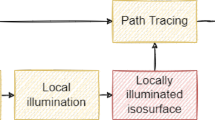Abstract
In this paper, a new volume rendering method with boundary enhancement is presented. The boundary is extracted and represented by surfaces explicitly. Then, using 3D texture mapping and graphics acceleration hardware, the volume data can be rendered with controllable boundary shading effect almost in real time. Test shows that this method is 4–5 times faster than the previous methods. Moreover, it can also be extended to render the surfaces and the volumetric data together interactively.
Similar content being viewed by others
References
Krueger W. Volume rendering and data feature enhancement.Computer Graphics, 1990, 24(5): 21–26.
Nelson M. Optical model for direct volume rendering.IEEE Transaction on Visualization and Computer Graphics, 1995, 1(2): 99–108.
Lacroute P, Levoy M. Fast volume rending using a sheat-warp factorization of the viewing transformation.Computer Graphics, 1994, 28(4): 451–458.
Laur D, Hanrahan P. Hierarchical splating: A progressive refinement algorithm for volume rendering.Computer Graphics, 1991, 25(4): 285–288.
Levoy M. Efficient ray tracing of volume data.ACM Transaction on Graphics, 1990, 9(3): 245–261.
Wilhelms J, Gelder A V. A coherent projection approach for direct volume rendering.Computer Graphics, 1994, 28(4): 275–284.
Yagel R. Towards real time volume rendering. InProc Graphicon’96, Saint Petersburg, Russia, 1996, pp.230–241.
Cabral B, Cam N, Foran J. Accelerated volume rendering and tomographic reconstruction using texture mapping hardware. InProc. ACM Symposium on Volume Visualization, 1994, pp.91–97.
Cullip T J, Neumann U. Accelerating volume reconstruction with 3D texture hardware. University of North Carolina Technical Report, UNC_93_027, 1993.
Fraster R. Interactive volume rendering using avanced graphics architectures. http://www.sgi.com, 1995.
Gelder A V, Kim K. Direct volume rendering with shading via 3D textures. InProc. ACM Symposium on Volume Visualization, 1996, pp.23–30.
Guan S Y, Lipes R. Innovative volume rendering using 3D texture mapping. InSPIE Medical Imaging 1994: Image Captures, Formatting and Display, SPIE 2164, 1994.
Teschner M, Henn C. Texture mapping in technical, scientific and engineering visualization. http://www.sgi.com, 1995.
Wilson O, Gelder A V, Wilhelms J. Direct volume rendering via 3D textures. University of California Technical Report, UCSC_CRL_94_19, 1994.
Moore, D, Warren J. Compact isocontours from sampled data. In Graphics Gems III, Academic Press, New York, 1992, pp.23–28.
Author information
Authors and Affiliations
Additional information
Supported by the National Natural Science Foundation of China.
Tong Xin received his M.S. degree from Zhejiang University in 1996. Now he is a Ph.D. candidate in the Department of Computer Science and Technology of Tsinghua University. His research interests include computer graphics, scientific visualization.
Tang Zesheng is a Professor in the Department of Computer Science and Technology, Tsinghua University. His research interests include computer graphics, scientific visualization, computational geometry and CAD technology.
Rights and permissions
About this article
Cite this article
Tong, X., Tang, Z. Hardware assisted fast volume rendering with boundary enhancement. J. of Comput. Sci. & Technol. 13, 393–401 (1998). https://doi.org/10.1007/BF02948497
Received:
Revised:
Issue Date:
DOI: https://doi.org/10.1007/BF02948497




